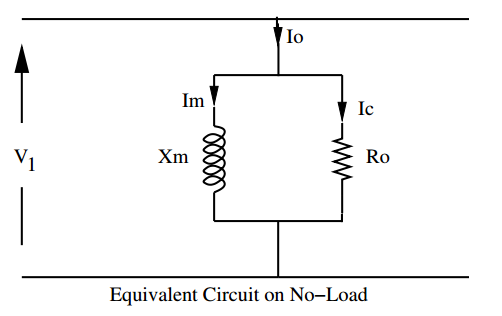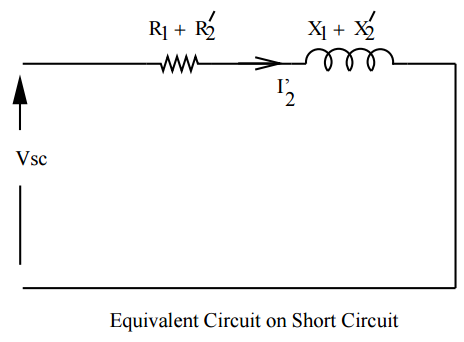Single Phase Transformer & Autotransformer
- A basic transformer consists of two separate windings of insulated wires wound around a common iron core.
- The power source or supply is hooked to the primary winding, and the load to be served is hooked to the secondary winding.
- Primary windings are connected to the alternating voltage source, and Secondary windings, are connected to the load. The iron core is used to link the flux in both windings.
- When the primary winding is energized an electromagnetic field builds up and then collapses in the iron core, this field cuts through the secondary coil winding inducing power to the load hooked to the secondary.
- This power buildup and collapse is called magnetic flux and occurs at a frequency of sixty times a second (60 Hz) in an a.c. circuit.
- Unlike in rotating machines, there is no energy conversion.
- Transformers are based on the principle of “mutual induction.” When current flows through a wire a magnetic field is produced.
- When a conductor passes through a magnetic field, a current flow will be induced through the wire.
- The method of transferring electrical energy by a transformer is done indirectly. Electrical energy is first converted into magnetic energy, then reconverted back into electrical energy at a different voltage and ampacity. Magnetism and electricity are closely related.

- By altering the number of windings on the primary and secondary, we can alter the number of volts and amps between the source and the load.
- The current in the secondary coil always changes by the inverse of the ratio by which the voltage changes.
- If the voltage is raised to n times its original value by the transformer, the current in the secondary coil will be reduced to one- n th the value of the current in the primary coil.
- The RMS value of induced emf can be found as:
- Primary induced emf E1 = 4.44 f N1 φm volt
- Secondary induced emf E2 = 4.44 f N2 φm volt.
- where, N1 = Number of turns in primary winding, N2 = Number of turns in secondary winding, f = Supply frequency in Hz, and φm = Maximum value of the magnetic flux in Wb
Transformer Ratio
- The input winding to a transformer is called the primary winding.
- The output winding is called the secondary winding.
- Step Down Transformer: If there are more turns of wire on the primary than on the secondary, the output voltage will be lower than the input voltage.
- Step-Up Transformer: If there are more turns of wire on the secondary than on the primary, the output voltage will be higher than the input voltage.
Turns Ratio = (Number of turns on the Primary) / (Number of turns on the Secondary)
Turns Ratio = (Primary Voltage) / (Secondary Voltage)
Turns Ratio = (Secondary Current) / (Primary Current)
Transformer Rating
- Transformers are rated in volt-amperes (VA) or kilovolt-amperes (kVA)
- When the volt-ampere (or kilovolt-ampere) rating is given, along with the primary voltage, then the primary full-load current can be determined as:
Full Load Current = VA rating / Voltage
Full Load Current = (kVA rating * 1000) / Voltage
Turns Ratio = (Secondary Full Load Current) / (Primary Full Load Current)
Example-1: A single-phase transformer with a 2-kVA rating has a 480-V primary and a 120-V secondary. Determine the primary and secondary full-load currents of the transformer.- Primary full-load current = ( 2 kVA * 1 000 ) / 480 V = 4.17 A
Secondary full-load current = VA rating / Secondary Voltage
- Secondary full-load current = ( 2 kVA * 1 000 ) / 120 V = 16.67 A
Types of Transformers
- Insulating transformers: Common two-winding transformers are often called insulating transformers. The primary winding and the secondary winding are separate and not connected.
- Auto transformers: An autotransformer has its windings interconnected so that the primary and the secondary share the same windings.
- Constant output voltage transformers: Constant output voltage transformers or voltage regulating transformers produce a nearly constant output voltage, even though the input voltage may not be constant.
Ideal Transformer
In ideal transformer shown below, has the following assumptions
- Its windings have no ohmic resistance, therefore it has no I2R loss (copper loss).
- There is no magnetic leakage, hence which has no core losses.
- The core has infinite permeability

Equivalent Circuit: The equivalent circuit of a machine is the circuit representation in terms of standard circuit elements which truly represents the performance of the particular equipment (see the below figure).
![]()
- Parameters: R1 = Primary winding resistance, R2 = Secondary winding resistance, X1 = Primary winding reactance, X2 = Secondary winding reactance, I0 = No load or exciting current, Ic= Core loss component of exciting current, Im = magnetising component of exciting current, Rc = Core loss equivalent resistance, Xm = Magnetising reactance, V1 = Primary voltage source, and V2 = Secondary terminal voltage.
Equivalent Circuit Referred to Primary Side: When all parameters are referred to the primary side.
Here,


- R'2 is Secondary resistance referred to the primary side
- X'2 is Secondary leakage reactance referred to the primary side
- I'2 is Secondary current referred to the primary side
- V'2 is the Secondary voltage referred to on the primary side

- Secondary induced emf referred to primary side:

- Equivalent resistance referred to the primary side:

- Equivalent reactance referred to the primary side:

- Equivalent impedance referred to primary side:

Equivalent Circuit Referred to Secondary Side: When all parameters are referred to the secondary side.

- Primary resistance referred to the secondary side:

- Primary leakage reactance referred to the secondary side:

- Primarily induced emf referred to secondary side:

- Primary current referred to secondary side:

- Equivalent resistance referred to secondary side:

- Equivalent reactance referred to the secondary side:

Voltage Regulation: Voltage regulation is defined as the rise in secondary terminal voltage expressed as a fraction of full load rate voltage when the full load is removed while maintaining input (primary) voltage constant.
Voltage regulation:

it is the same as

- Voltage regulation (at tagging power factor):

- Voltage regulation (at leading power factor):
Losses in Transformer
- Iron or Core Loss (Constant): The losses which occur in a transformer are as follows:
- Pi = Ph + Pe Where, Pi = Iron or core loss, Ph = Hysteresis loss, and Pe = Eddy current loss.
- This loss is the sum of hysteresis (Ph) and eddy current loss (Pe). It is denoted by Pi.
- Eddy Current Loss:
where, Ke = Proportionality constant depends upon core material, f = Supply frequency, Bm = Maximum flux density in the core, and t = Thickness of laminations.
But,

![]()
Eddy current loss is proportional to the square of the applied voltage and independent of frequency. It can be reduced by thin lamination.
- Hysteresis Loss
![]() and
and 
Therefore
Where, x = Steinmetz constant (range from 1.6 to 2.5). Hysteresis loss depends upon both the applied voltage and frequency.
- Copper Loss or I2R Loss (Variable):
- Total copper loss in transformer = primary winding copper loss + secondary winding copper loss.
Transformer Efficiency
- Transformer Efficiency (η ) = Output power / Input power
- Transformer Efficiency (η ) = Output power / (Output power + Losses)
- Transformer Efficiency (η ) = output power / (output power+ iron losses+copper losses)

Where, Pi = Iron or core loss, Pc = Copper loss
Transformer Tests
Open circuit and short circuit tests are performed to determine the circuit's constant efficiency and regulation without actually loading the transformer.
1. Open Circuit (OC) Test:- OC test is carried out at rated voltage usually on the low voltage side with the high voltage side open.
- This test is used to determine the core loss at rated voltage conditions.
- Since the secondary terminals are open (no load is connected across the secondary), the current drawn from the source is called as no-load current.
- Under the no-load condition, the power input to the transformer is equal to the sum of losses in the primary winding resistance and core loss.
- Since no load current is very small, the loss in winding resistance is neglected. Hence, on no load the power drawn from the source is dissipated as heat in the core.


- Wattmeter reading = iron or core loss Pi
- Voltmeter reading = primary rated voltage x (V1)
- Ammeter reading = no-load current (I0)
![]()

![]()


- Suppose the input voltage is reduced to a small fraction of the rated value and secondary terminals are short-circuited. A current will circulate in the secondary winding.
- Since a small fraction of rated voltage is applied to the primary winding, the flux in the core and hence the core loss is very small. Hence, the power input on a short circuit is dissipated as heat in the winding
- A short test is carried out at the rated current to determine the full load copper loss.


- Wattmeter reading = full load copper loss of transformer (Pcfi)
- Voltmeter reading = short circuit voltage (I1SC)
- Ammeter reading = full load primary current f(I1SC)
![]()
- Equivalent resistance:

Autotransformer
This single winding is “tapped” at various points along its length to provide a percentage of the primary voltage supply across its secondary load. Then the autotransformer has the usual magnetic core but only has one winding, which is common to both the primary and secondary circuits.
Therefore in an autotransformer, the primary and secondary windings are linked together both electrically and magnetically. The main advantage of this type of transformer design is that it can be made a lot cheaper for the same VA rating, but the biggest disadvantage of an autotransformer is that it does not have the primary/secondary winding isolation of a conventional double-wound transformer.
The section of winding designated as the primary part of the winding is connected to the AC power source with the secondary being part of this primary winding. An autotransformer can also be used to stop the supply voltage up or down by reversing the connections. If the primary is the total winding and is connected to a supply, and the secondary circuit is connected across only a portion of the winding, then the secondary voltage is “stepped-down” as shown
This single winding is “tapped” at various points along its length to provide a percentage of the primary voltage supply across its secondary load. Then the autotransformer has the usual magnetic core but only has one winding, which is common to both the primary and secondary circuits.
Therefore in an autotransformer, the primary and secondary windings are linked together both electrically and magnetically. The main advantage of this type of transformer design is that it can be made a lot cheaper for the same VA rating, but the biggest disadvantage of an autotransformer is that it does not have the primary/secondary winding isolation of a conventional double-wound transformer.
The section of winding designated as the primary part of the winding is connected to the AC power source with the secondary being part of this primary winding. An autotransformer can also be used to stop the supply voltage up or down by reversing the connections. If the primary is the total winding and is connected to a supply, and the secondary circuit is connected across only a portion of the winding, then the secondary voltage is “stepped-down” as shown.

The voltages developed in the windings are dependent on the flux linkages. The windings are wound on the same magnetic core so they link the same flux.
- V1 / N1= V2 / N2.
So whenever voltage V1 exist across the primary winding, then voltage V2 will be induced across the secondary winding irrespective of changes in connections.
Similarly, the magnetic circuit demands that mmf should be balanced. It implies the primary side ampere turn should equal the secondary side ampere turn.
- I1 . N1= I2 . N2
Here,
- Autotransformers are also used for voltage regulation in distribution networks, for starting induction motors and as lighting dimmers. Autotransformers are also used in electric traction.
- One main disadvantage of autotransformers is that the primary and secondary are electrically connected. So the electrical disturbance i.e. high voltage transients from one side can be easily transmitted to the other side.
- The other disadvantage is that the impedance of the autotransformer is considerably low, so the short circuit current will be more.
- More an open circuit in common winding results in full primary side voltage across the load which is harmful.

Disadvantages of an Autotransformer
- The main disadvantage of an autotransformer is that it does not have the primary to secondary winding isolation of a conventional double-wound transformer. Then an autotransformer can not safely be used for stepping down higher voltages to much lower voltages suitable for smaller loads.
- If the secondary side winding becomes open-circuited, current stops flowing through the primary winding stopping the transformer action and resulting in the full primary voltage being applied to the secondary terminals.
- If the secondary circuit suffers a short-circuit condition, the resulting primary current would be much larger than an equivalent double-wound transformer due to the increased flux linkage damaging the autotransformer.
- Since the neutral connection is common to both the primary and secondary windings, earthing of the secondary winding automatically Earth’s primary as there is no isolation between the two windings. Double-wound transformers are sometimes used to isolate equipment from the earth.
The autotransformer has many uses and applications including the starting of induction motors, used to regulate the voltage of transmission lines, and can be used to transform voltages when the primary to secondary ratio is close to unity.
An autotransformer can also be made from conventional two-winding transformers by connecting the primary and secondary windings together in series and depending upon how the connection is made, the secondary voltage may add to, or subtract from the primary voltage.
If you are preparing for GATE and ESE, avail Online Classroom Program to get unlimited access to all the live structured courses and mock tests from the following link :
- ESE and GATE ECE Online Classroom Program (24+ Live classes and 150+ mock tests)
- ESE and GATE EE Online Classroom Program (24+ Live classes and 193+ mock tests)








Comments
write a comment